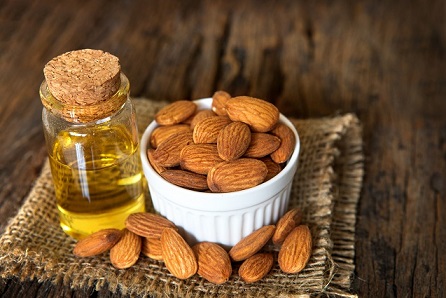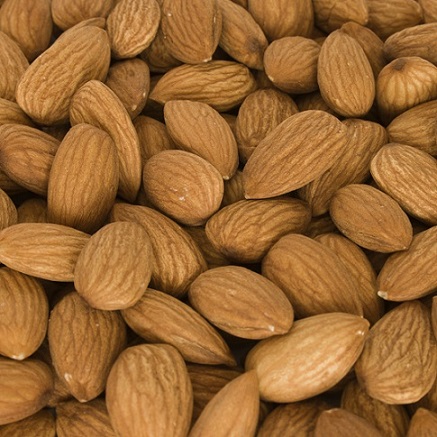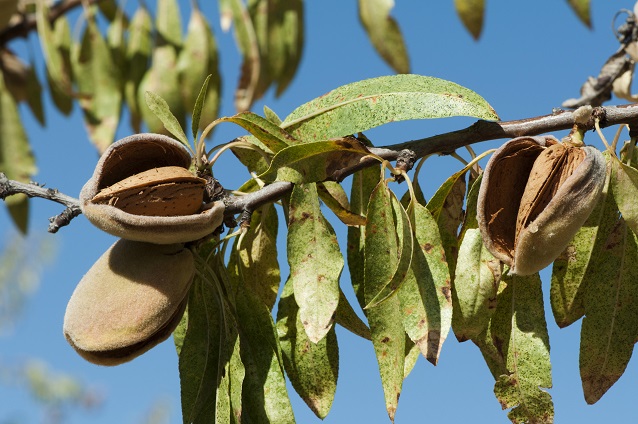The almond is the riskiest, yet most potentially rewarding food for acne in a grocery store.
The almond has the most optimal nutrition for acne of almost any food. It’s like nature designed this nut to provide humanity with clear skin, and waited patiently for us to discover it.
But the almond has a downside as well – it’s so complex and rich in defensive compounds that countless acne patients have reported in with fresh pimples.
The almond is not a botanical nut – it’s actually the seed of the almond fruit. Its job is to embed itself in the soil, sprout, and form a whole new almond tree.
Consequently, it comes equipped with endless nutrition to accomplish that task. Almonds are drenched in vitamins and minerals, fats, calories, enzymes, antioxidants, and phytonutrients. The nut contains every substance required to form new life.
Compared to a tiny piece of cucumber, there’s no comparison in the nutritional density, but the downside is that the almond seed does not want to be eaten. It is designed to plant and sprout itself, not to flavour a cake or be enjoyed as snack. For that reason, the almond is also loaded with antinutrients, unhealthy fats and natural plant toxins.
One way or another, almonds will have a big impact on your skin. Many acne patients have sworn against eating them forever, but if the stars align, they could clear your skin completely.
The light side 1# – vitamin E
 If there’s one reason why the gamble of almonds might pay off, it’s undoubtedly vitamin E. The almond isn’t just the richest nut, but one of the richest foods full stop in this all-important acne vitamin. A 50 gram handful of raw almonds contains contains 13.1mg, equivalent to 65% of the recommended daily allowance (RDA).
If there’s one reason why the gamble of almonds might pay off, it’s undoubtedly vitamin E. The almond isn’t just the richest nut, but one of the richest foods full stop in this all-important acne vitamin. A 50 gram handful of raw almonds contains contains 13.1mg, equivalent to 65% of the recommended daily allowance (RDA).
Vitamin E is the single greatest vitamin for acne. We’ve discussed its powers endlessly on this website, but in short, the sticky oil covering your face consists of 12% squalene, a fatty acid.
Oil is perfectly capable of clogging your skin pores normally, but when squalene oxidises, after being assaulted by free radicals from air pollution or cigarette smoke wafting around, it transforms into squalene peroxide. This substance is double the disaster for clogged pores, triggering yet more oil production and a surge in immovable dead skin cells.
An experiment discussed here showed a clear connection, as teenage acne patients had 24% less alpha tocopherol (the main active form in nature) in their sebum.
No acne patient with good sense can ignore vitamin E, and feasting on almonds is the tastiest and most convenient way to get it. Compare almonds to other foods. The hazelnut, an excellent food for acne, contains 37% of the RDA per 50 grams, but pecans and cashew nuts contain just 3% and 2% respectively.
Read Annihilate Your Acne – get the diet that could transform your skin!
Almonds have a rare thing as well: studies confirming that they raise bloodstream levels. This study gathered male smokers and fed them 84 grams of almonds per day. Bloodstream alpha tocopherol increased by 10%. This study fed 50 grams of almonds to trained endurance athletes each day. Ten weeks later, their vitamin E levels far exceeded the controls group’s. Aside from the almonds, their nutritional intake of vitamin E was exactly the same.
This study compared two groups of humans, who had equal blood levels of vitamin E at baseline. After 4 weeks of feasting on 50 grams daily, the almond group had substantially higher alpha tocopherol levels than the control group.
Vitamin E is the main reason why almonds can be a superweapon for acne. Eat 50 almonds per day, every day, and you could strike gold and clear your acne within weeks.
The light side 2# – antioxidants
The second big benefit for acne, meanwhile, is all the other antioxidants found in almonds.
Almonds have an ORAC score of 4454 per 100 grams, higher than strawberries with 4302 and slightly lower than blueberries with 4669. The ORAC scale measures any given food’s overall antioxidant capacity. Almonds have countless antioxidant types other than vitamin E, and like vitamin E, they clear acne by protecting your sebum and deactivating free radicals, each through a moderately different pathway.
Almonds are especially rich in polyphenols and flavonoid antioxidants, including quercetin, catechins, kaempferol and isorhamnetin. Almost of all are concentrated in the almond skin. This study identified 9 new antioxidants in almonds, including naringenin and vanillic acid. Almost all deactivated free radicals effectively; numbers 6 and 7 had “very strong activity”, the others had “strong” activity whereas only number 4 had “weak” activity.
Almonds are one of the greatest sources of the antioxidant epicatechin, with 2.6mg per 100 grams. Hazelnuts beat almonds with 2.9mg, but almonds beat strawberries (0.06mg), pomegranates (0.16mg), green grapes (0.02mg), and blackberries (0.15mg).
7 natural topical treatments which could transform your skin
Only the banana comes close among fruits, with 2.14mg. Epicatechin was found in this study to protect human skin tissue from UV radiation. It was concluded that “this dietary flavanol has the potential to protect human skin against the deleterious effects of sunlight”. Almonds are the way to get it.
The variety of antioxidants is wide, meaning that almonds can come at free radicals from countless directions at once.
The effects of almonds on the human body are also surprising. This study on 60 male smokers found that eating almonds could increase the body’s production of glutathione by 16% and superoxide dismutase by 35%.
SOD and GSH are the two main antioxidants which are manufactured by the human body itself. The high levels of the glutathione co-factor magnesium in almonds might be responsible, or it could be an unidentified compound. Additionally, two markers of free radical activity called 8-hydroxy-deoxyguanosine and malondialdehyde fell by 28% and 34% respectively.
This study was particularly interesting. It found that catechin, epicatechin, isorhamnetin, quercetin and kaempferol were the prime antioxidants in almond skins. Yet they still represented only 3.6% of the total antioxidants. Where are all the other antioxidants?
I personally believe that there’s a major unique antioxidant in almonds which hasn’t been identified yet. Almonds have such a distinctive flavour, and in the spice cinnamon, the compound cinnamaldehyde is responsible for the strong aroma. There must be some unique and hopefully acne-clearing compound in almonds.
Why bread and pasta are a massive cause of acne
All this culminated in a study where 84 grams of almonds reduced overall levels of oxidative stress in humans by 23-24% after four weeks. Oxidative stress is the bodily balance between antioxidants and free radicals; an unhealthy balance is the root cause of acne, alongside chronic inflammation.
It’s pretty clear that almonds are a monster antioxidant source, and a tasty one too.
The dark side 1# – the fat profile
 However, it all goes wrong for almonds starting right now. If almonds are so loaded with acne nutrition, then why do they actually worsen acne in so many? It all starts with the fat composition, a common problem with nuts.
However, it all goes wrong for almonds starting right now. If almonds are so loaded with acne nutrition, then why do they actually worsen acne in so many? It all starts with the fat composition, a common problem with nuts.
Nuts are fatty foods by their very nature. Fat is a form of energy for the seed to grow in its fledgling stages. The sweet almond sold commercially (as opposed to the bitter, cyanide-laced almond used to make oil) consists of 49.4% fat, 21.2% protein, and 3.9% sugar.
There’s no risk of a carbohydrate overdose and the resulting oily skin, as you might have shrewdly deduced, because the sugar levels are tiny. Here’s how the fat content in almonds breaks down: roughly 10% is saturated, 70% is monounsaturated and 20% is polyunsaturated. 99.99% of those polyunsaturated fats are omega 6s, AKA linoleic acid, with a tiny percentage being linolenic acid, or omega 3s.
How do these fats trigger acne? An overdose of omega 6 fats is a shortcut to an overactive immune system and all of the red pimples that come with it. Eat too many almonds and an overdose is exactly what you get.
The most important factor is the ratio of omega 6s to omega 3s. The optimal dietary ratio for keeping inflammation low is 3:1 to 1:1. In almonds, the ratio is 2000:1.
Sea buckthorn oil – a natural secret for acne and oily skin
Ask yourself – do you eat a standard American diet? Do you enjoy plenty of fast food, fries, and cook your meats with soybean oil? If the answer is yes, then your intake of omega 6 fatty acids is already spiralling out of control, and eating mountains of almonds will add to that, no matter how nutritious they are.
With the strategies I outlined in my eBook Annihilate Your Acne, you can slot nuts like almonds into an acne-friendly diet with ease. For the average man or woman, the fat composition is a big hidden reason why almonds cause acne.
The dark side 2# – toxins
By far the worst hidden acne villain is the defensive plant toxins.
Almonds contain so many natural weapons that your chances of breaking out from at least one are seriously high. Our first example is the oxalates/oxalic acid. Oxalates are plant compounds which bind to minerals like magnesium and inhibit their absorption. They’re the reason why spinach and rhubarb cause kidney stones in susceptible people.
Importantly for acne, oxalates can also cause inflammation in susceptible people. Some human beings lack the oxalate-degrading gut bacteria required to digest oxalates. So instead, they pass into the bloodstream and bind to calcium molecules, forming crystals which must be destroyed, and increasing the overall inflammatory burden of the body.
Skin rashes are a classic symptom of oxalate sensitivity. Oxalates can also bind to existing minerals in your body and drain your acne-clearing supply.
Zinc – the number one mineral for clear skin (reduces acne by 49.8%)
Almonds are the commercial food with the fifth most oxalates. They contain 133mg per 100 grams, whereas spinach, the supreme overlord of oxalic acid, contains 755mg. Almonds surpass all other culinary nuts with ease; the closest contender is the cashew nut with 49mg.
Almost all foods contain such inconsequential levels of oxalates that there are no visible effects, but almonds are an exception.
Furthermore, this study found that the average oxalate absorption from almonds was significantly higher than that of black beans. Plants can contain either soluble or insoluble oxalates; almonds are richer in the well-absorbed soluble oxalates.
The fact that almonds are eaten raw matters, because with spinach or kale, the boiling deactivates a vast swathe of them. If your gut bacteria is impoverished like the average person then almonds can easily trigger skin problems.
For acne, the rich nutrition of almonds is a double edged sword. Almonds also contain 1280mg of phytic acid, another mineral-binding organic acid. They’re a concentrated source of lectins, defensive toxins which stick to the gut lining and wreak digestive havoc depending on your dietary intake elsewhere. Almonds contain enzyme inhibitors which damage your digestion of acne nutrients, in addition to the absorption damage.
Every one of those weapons is designed to keep you, the predator, from eating the almond seed.
Finally, almonds can be a dirty food, a risky crop for mycotoxin contamination. Low quality almond plants are commonly contaminated with the mould species Aspergillus flavus and Aspergillus parasiticus, which specialise in churning out aflatoxins. This mycotoxin subtype can inflame any human being mildly, but sensitive acne patients are particularly at risk.
If your body is in fantastic shape from top to bottom, you might be able to feast on almonds without a pimple in sight. If it isn’t, then the story changes.
The verdict
There’s next to no chance that almonds will be neutral for acne, if you eat a good handful daily. The vitamin E and antioxidants are unrivalled among nuts, but the real question is whether you can withstand the omega 6s and the plant toxins.
Have you previously noticed acne outbreaks from other nuts, or from seeds, which share a similar profile of antinutrients? Perhaps you’ve already been following an acne-friendly diet for months. Your digestion, your gut bacteria, your skin cells and your entire system may have already strengthened. You never know; you might be able to feast on almonds now, both for pleasure and vitamin E.
If you follow the standard American diet and know nothing about clearing acne naturally, then almonds are a bigger threat. But what if your pimples are entirely down to a vitamin E deficiency? Almonds would be a godsend. The toxins would be left by the wayside.
We are left with only one solution – eat this nuclear bomb of an acne treatment and closely monitor the effects. You might destroy your skin or you could revolutionise it, but there’s only one way to find out.
Will almond oil save your skin?
Our final question is about almond oil. This is a rapidly spreading topical remedy, for rubbing into the face and leaving it smooth and glowing with a fine goldenness. Unfortunately, it’s fairly overrated.
Almond oil is simply the raw fats of the whole almond nut. Like grapeseed oil, this can be extracted either with a traditional cold-pressing or high-tech chemical bombardment. The fat profile is identical to whole almonds, with 70% oleic acid, and oleic acid happens to be the worst fatty acid you could apply to your face.
It’s great when eaten, strengthening the heart, but topical oleic acid (AKA omega 9) badly destabilises the skin barrier, resulting in decreasing moisture retention, micro-fissures and inflammation, not to mention vulnerability against air pollution and other irritants. The oleic acid content is equal to olive oil, and that’s why we recommend against olive oil as a topical treatment.
Luckily, we’re not missing much: almond oil is fairly weak anyway. There are no special features like the collagen-boosting properties of tamanu oil, or the carotenoids of sea buckthorn oil. Almond oil does have plenty of vitamin E, transferred from the nut, but so does grapeseed oil, which is far safer.
There’s also a promising sunscreen study, where mice were treated with almond oil before basking in UV radiation for several hours. This prevented antioxidant depletion and “structural damage” in the skin, which is excellent for acne, but that’s easily accessible with a serving of sweet potatoes and their carotenoids.
You could argue that the detailed palette of antioxidants gives the oil promise, but most of them are concentrated in the skin, such as naringenin and vanillic acid, and never make their way to the oil.
Does almond oil have any potential then? You should never use it as a topical remedy in isolation, unless you’re prepared to sacrifice your skin to acne research, but you could easily combine it with a low oleic acid oil like grapeseed to dilute the dangers and make whatever benefits it has like sunscreen properties more accessible.
As a food, the situation flips on its head, as almond oil is a tasty alternative to ever-present acne nightmares like canola oil.
Oleic acid is harmless inside the body, which makes almond oil an excellent taste alternative to extra virgin olive oil, to add variety to your diet. The two oils are quite similar overall, with 70% oleic acid. Almond oil actually contains more vitamin E per 100 grams at 39.2mg versus 14.3mg.
The problem of omega 6s remains, with almond oil consisting of 20% versus just 10% in olive oil, but by rearranging your diet you can make this harmless – it’s similar to whole almonds. Almond oil also contains a mere fraction of the oxalates and phytic acid, as these toxins are concentrated in the skins and fibres and are left behind during the oil’s extraction.
Which brand to buy? Cold-pressed and extra virgin is a must. Organic is also preferable, and this Sweet Almond Oil by Sky Organics is a great brand. Why the word sweet? Because it’s made from culinary almonds; the wild almond isn’t so sweet, and replaces sugar with a delicious helping of cyanide.
Almond oil is identical to extra virgin olive oil: out of bounds as a topical treatment unless diluted with safer oils, but a tasty food for feeding your skin nutrition.
NEXT: discover the root causes of acne and banish your pimples forever
Thanks for reading!


What about walnuts, Richard? Do they have any secret acne or brain boosting powers compared to almonds?
Greetings Matt, walnuts aren’t a terrible food to eat for acne, but compared to almonds they’re high in polyunsaturated fats (specifically linoleic acid). they’re decent at increasing bloodstream antioxidants but not as effective as hazelnuts. As for the brain they seem to prevent the formation of amyloid plaques, the plaques behind Alzheimer’s. I wouldn’t wolf down vast amounts of walnuts from the bag, but they’re certainly an acne-friendly treat to have in moderation. One day I will write a full article about them.
Soaking almonds in water overnight can supposedly remove some of the phytic acid.
Hi Richard, what do you think about peanut butter as a vegan protein source?